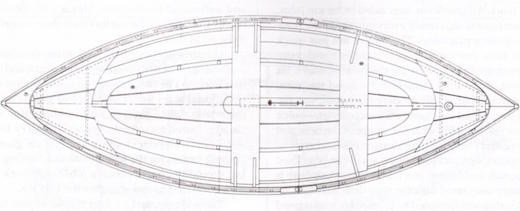It seems like every week I get a letter or an e-mail that goes something like this: “Love your HESPERUS design, but I really need it (x) feet (shorter or longer).” Usually the inquirer wants to shrink the boat to fit into an existing shop space. Since I answer this question so often I thought it might be interesting to discuss resizing a boat design here.
Let’s explore what happens when you change the size of a boat. If you simply multiply each dimension of the hull by a constant, some basic laws of proportion kick in. If, for example, you multiply by two, then the length, beam and draft all double, the sail area increases by four times, the displacement (volume) goes up by eight times, and the stability jumps by 16 times. Think about these last two numbers for a moment, because these proportions work in both directions. Making a boat smaller in all dimensions can dramatically reduce its displacement and stability, both of which are intimately connected with safety.
As an extreme example, take a look at model sailboats. Compared with their full sized sisters, they will have huge and very deep ballast keels, necessary because the miniaturization of their hulls has resulted in greatly reduced form stability. For instance, the Star Class sailing model has a length/draft ratio of 3.91 while a full sized Star has a ratio of 6.81, equivalent to a “real world” draft of nearly 6 feet. And not only is the model’s keel proportionately much deeper, it also has a much heavier ballast bulb on the bottom of it, to help pump up sail carrying power of the tiny hull.
Dads and Grandpas (as well as similarly boat-crazed females) take note: by the same math, one of the most dangerous things you can do is to build a reduced-size version of a boat for the kids. It might look cute, but kids need a full-sized boat for safety. As boats get smaller, their proportions need to change to maintain adequate stability and volume. Specifically, beam and freeboard must increase.
“Well then, how about enlarging a design? Your math says that would be OK.” From the point of view of safety alone, that statement is generally true. However, from the aspect of appearance and performance, you might be very disappointed. A surprisingly small multiplication of size can result in a “Baby Huey” looking boat—that is, one that appears bloated and cartoon-like. And since a relatively small increase in each linear dimensions will produce a large increase in volume, you can wind up with a boat that either floats too high or requires a great deal more ballast than you expected in order to make it float on the desired waterline. These are the reasons that as boats get bigger, they generally get proportionately narrower and lower, and can carry bigger rigs.
In fact, there are some simple ways that dimensions can be changed and still result in a good boat. Probably the safest approach is to simply add length by increasing station spacing, leaving the beam and heights the same. This will often produce an acceptable boat (often even a better one) because it works in the same proportional direction as the “natural” scheme of things: shortening the boat makes it proportionately wider, lengthening it makes it proportionately narrower. This method results a relatively small change in “size” since only one dimension is changed.

. . . sign up to the right to get immediate access to this full post,
plus you'll get 10 of our best videos for free.
Get Free Videos& Learn More Join Now!!for Full Access Members Sign In


David Blessing says:
One issue is initial stability. I lengthened a fine canoe-body rowboat made with glued lap lightweight plywood. Almost all the displacement was my weight. The resulting boat was tender. Outfitters and long oars made this manageable.
Geoff Kerr says:
I’m a very lucky boatbuilder in that I get to teach at the WoodenBoat School in the summers. I usually do a two week glued lapstrake plywood design, in a class in which ten or so students work together to build one boat and get as far as we can. We’ve done Caledonias, Ness yawls, Arctic Terns and Coquinas over the years. This year’s boat will be Beach Pea, and just to add to the fun we’ve decided to do two hulls, the 15′ tricked out for sail, and the 13′ as a pulling boat I built a 15′ this past Spring and thoroughly enjoyed both the build and the end product. I highly recommend this design as a gorgeous, useful boat and a readily approachable project..
David Tew says:
Many years ago we had a beautifully proportioned fifteen foot (LOA) dory built by Malcolm Brewer of Camden in his ‘retirement shop’ on Bayview Street. It rowed and behaved well in all conditions given the type. Someone else admired it but wanted to size it down to fourteen feet, which they did by reducing all dimensions. Just that much of a reduction made the boat dramatically more tender and much less enjoyable to row.
Arthur Maroney says:
Well stated and interesting.